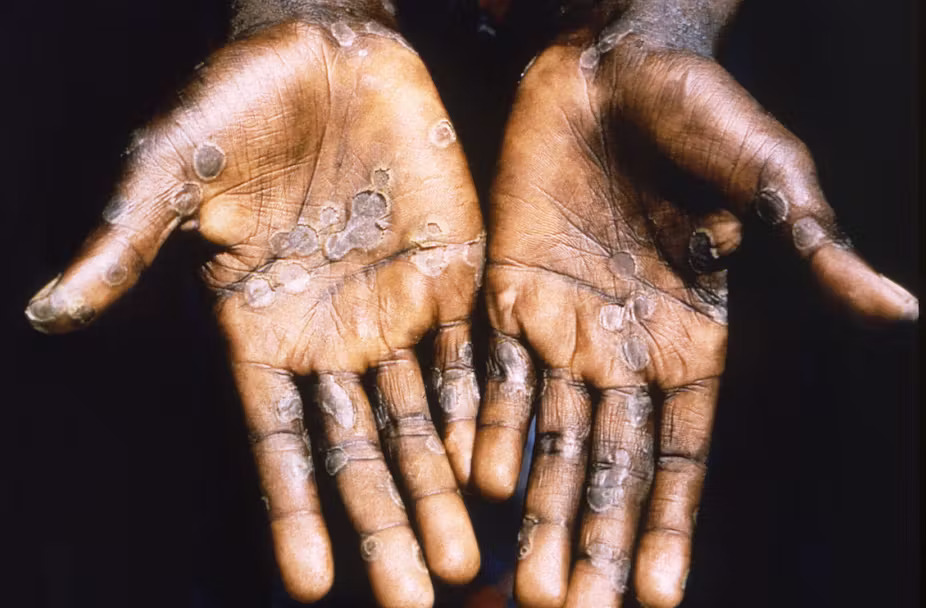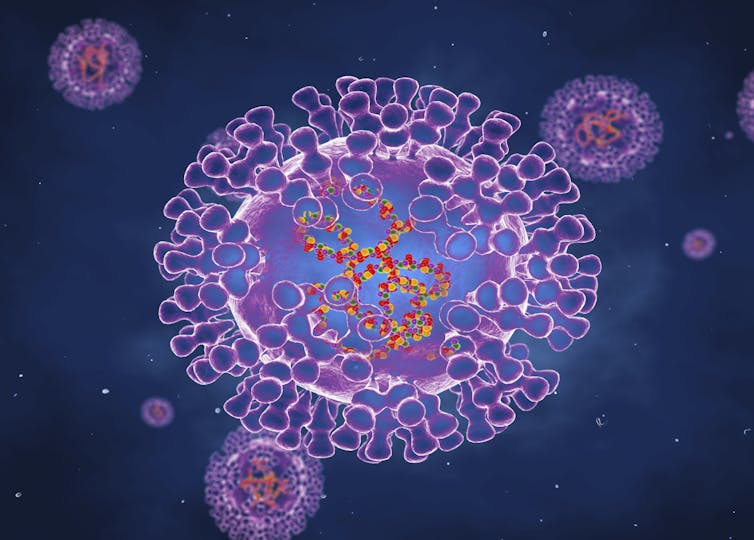These moves come after a virulent strain of the disease spread rapidly to 16 countries and six new countries were affected in 10 days.
There have been 15,132 mpox confirmed cases in Africa since the beginning of 2024. Some of the countries affected are Burundi, Cameroon, Congo, Ghana, Liberia, Nigeria, Rwanda, the Democratic Republic of Congo, South Africa, Uganda and Kenya.
Virologist Cheryl Walter sets out some of the reasons the mpox outbreaks are so worrying.
How many strains of mpox are there and which ones should we be worried about?
Mpox is one species of pox virus, such as smallpox and cowpox, characterised by a rash followed by bumps that appear on the skin. With mpox the bumps then fill with liquid and eventually scab over.
As we’ve come to know through diseases such as COVID-19, viruses change genetically and mutate quite quickly.
Mpox is no different, although pox viruses typically mutate much more slowly compared to other viruses, such as HIV. HIV changes approximately every three times a single virus replicates.
There are two strains of mpox – clade I and clade II. Think of them as two big branches on a tree.
Until about five or six years ago these clades weren’t that diverse.
Something has changed. These branches are growing and the leaves on the branches are becoming more numerous. In fact, we have new subclades for both I and II, so two new offshoot branches have appeared.
Clade II is far less dangerous with a case fatality rate of about 0.1%. In other words, roughly one person in a thousand dies.
Now scientists are seeing thousands of cases of clade I being reported in 16 countries in Africa and a case fatality rate of anything from 3% to 4%. That means three or four people in a hundred die. Many cases are children.
Let’s use COVID-19 again as a comparison. It was declared an international public emergency from 30 January 2020 to 31 December 2021, with an estimated case fatality rate of 1.2%.
Mpox is a relatively understudied virus. Until recently there were a handful of confirmed cases every year. It occurred primarily in tropical rainforest areas of central and west Africa. There was very little opportunity for the virus to adapt to a human host.
We don’t understand if genetic changes are making these viruses spread more easily and if the variants in circulation are more dangerous.
We do know the virus is changing and moving through lots of people. Viruses can only mutate when they’re passing through a host such as a human.
The more people it passes through, the more opportunity it has to change and potentially become more virulent or more transmissible.
Now this virus is moving through lots of people, there are lots of these opportunities.
Read more: Mpox: what to watch out for, treatment and what to worry about
How does the disease spread to new areas?
The virus spreads through contact such as sharing utensils, plates, towels and bedding.
Women and children are disproportionately affected through skin-to-skin contact because they are close to each other every day. Children play games in schools and creches (a nursery where babies and young children are cared for during the working day) and touch objects and each other all the time.
Viruses also spread easily when people live in densely populated, low income areas and can’t isolate themselves because they have to bring in an income.
Two of the other other reasons mpox spreads quickly is the longer incubation period and vague symptoms.
The incubation period ranges quite widely from five to up to 21 days. A person can become infected with mpox during this period and travel to another country and transmit the disease to others.
The initial symptoms are vague and include swollen glands, fever and feeling a bit run down. It is estimated 10% of people infected with mpox are asymptomatic.
It’s only when the rash appears that it might become apparent that it’s not a cold or flu or COVID-19.
To add to that challenge, when children get those rashes they could be mistaken for chickenpox or one of the other childhood infectious diseases.
What emergency measures need to be put in place to ensure the outbreak doesn’t explode into a pandemic?
There are a couple of things stacked against African health agencies trying to contain the virus.
There are few resources to fight this disease and the shortage of vaccines is a major problem. The Africa Centres for Disease Control estimates there are only 200,000 doses available to African countries compared with a demand of at least 10 million.
However, there’s still a lot that can be done.
Testing: This is the number one tool in this fight. We need to know where these cases are and who in the community mpox is passing through. We also need to use this data to trace contacts. We can do this with simple lateral flow tests – using a swab of the nose and/or throat that can be done in the community and give results within 30 minutes.
Messaging: In the previous outbreak across the world, a lot of communications that were going out were aimed at sex workers and men who have sex with men. As a result, people may have thought that this is only a sexually transmitted disease. It’s not.
Now women and children are getting the virus, so communities need to be told what symptoms to look for and what action to take.
Vaccinating: Because mpox is so similar to smallpox, we can use that vaccine. However there are limited stockpiles and we can’t manufacture smallpox vaccines quickly enough. The WHO has called for vaccine candidates for fast approval and distribution.
These measures and others need to be taken urgently to contain and to repress this epidemic before it potentially becomes a global pandemic.
Read more: At what point is a disease deemed to be a global threat? Here’s the answer
–
Partners

University of Hull provides funding as a member of The Conversation UK.
View all partners
Republish our articles for free, online or in print, under a Creative Commons license.
–
Want to write?
Write an article and join a growing community of more than 188,300 academics and researchers from 5,024 institutions.















Neil John – I know this might be seen as antagonistic, but is there a relationship between the mpox and covid viruses, and their moreover the mRNA jabs, causing mutation and/or greater susceptibility to mpox? Are we likely to see similar patterns of greater susceptibility due to imprinting following mRNA mpox jabs, as we’re now discovering with covid mRNA jabs?
–